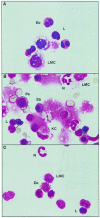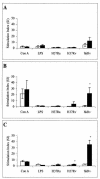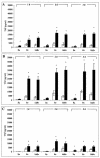Effect of Mycobacterium bovis BCG vaccination on Mycobacterium-specific cellular proliferation and tumor necrosis factor alpha production from distinct guinea pig leukocyte populations
- PMID: 14638793
- PMCID: PMC308898
- DOI: 10.1128/IAI.71.12.7035-7042.2003
Effect of Mycobacterium bovis BCG vaccination on Mycobacterium-specific cellular proliferation and tumor necrosis factor alpha production from distinct guinea pig leukocyte populations
Abstract
In this study, we focused on three leukocyte-rich guinea pig cell populations, bronchoalveolar lavage (BAL) cells, resident peritoneal cells (PC), and splenocytes (SPC). BAL cells, SPC, and PC were stimulated either with live attenuated Mycobacterium tuberculosis H37Ra or with live or heat-killed virulent M. tuberculosis H37Rv (multiplicity of infection of 1:100). Each cell population was determined to proliferate in response to heat-killed virulent H37Rv, whereas no measurable proliferative response could be detected upon stimulation with live mycobacteria. Additionally, this proliferative capacity (in SPC and PC populations) was significantly enhanced upon prior vaccination with Mycobacterium bovis BCG. Accordingly, in a parallel set of experiments we found a strong positive correlation between production of antigen-specific bioactive tumor necrosis factor alpha (TNF-alpha) and prior vaccination with BCG. A nonspecific stimulus, lipopolysaccharide, failed to induce this effect on BAL cells, SPC, and PC. These results showed that production of bioactive TNF-alpha from mycobacterium-stimulated guinea pig cell cultures positively correlates with the vaccination status of the host and with the virulence of the mycobacterial strain.
Figures




References
-
- Aggarwal, B. B., and K. Natarajan. 1996. Tumor necrosis factors: developments during the last decade. Eur. Cytokine Netw. 2:93-124. - PubMed
-
- Allen, P. M., and E. R. Unanue. 1984. Differential requirements for antigen processing by macrophages for lysozyme-specific T cell hybridomas. J. Immunol. 132:1077-1079. - PubMed
-
- Bartow, R. A., and D. N. McMurray. 1997. Cellular and humoral responses to mycobacterial stress proteins in experimental pulmonary tuberculosis. Tub. Lung Dis. 78:185-193. - PubMed
-
- Bean, A. G., D. R. Roach, H. Briscoe, M. P. France, H. Korner, J. D. Sedgwick, and W. J. Britton. 1999. Structural deficiencies in granuloma formation in TNF gene-targeted mice underlie the heightened susceptibility to aerosol Mycobacterium tuberculosis infection, which is not compensated for by lymphotoxin. J. Immunol. 162:3504-3511. - PubMed
Publication types
MeSH terms
Substances
Grants and funding
LinkOut - more resources
Full Text Sources
Medical

